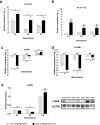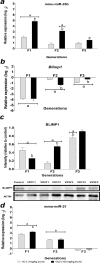Exposure to endocrine disruptor induces transgenerational epigenetic deregulation of microRNAs in primordial germ cells
- PMID: 25897752
- PMCID: PMC4405367
- DOI: 10.1371/journal.pone.0124296
Exposure to endocrine disruptor induces transgenerational epigenetic deregulation of microRNAs in primordial germ cells
Abstract
In mammals, germ cell differentiation is initiated in the Primordial Germ Cells (PGCs) during fetal development. Prenatal exposure to environmental toxicants such as endocrine disruptors may alter PGC differentiation, development of the male germline and induce transgenerational epigenetic disorders. The anti-androgenic compound vinclozolin represents a paradigmatic example of molecule causing transgenerational effects on germ cells. We performed prenatal exposure to vinclozolin in mice and analyzed the phenotypic and molecular changes in three successive generations. A reduction in the number of embryonic PGCs and increased rate of apoptotic cells along with decrease of fertility rate in adult males were observed in F1 to F3 generations. Blimp1 is a crucial regulator of PGC differentiation. We show that prenatal exposure to vinclozolin deregulates specific microRNAs in PGCs, such as miR-23b and miR-21, inducing disequilibrium in the Lin28/let-7/Blimp1 pathway in three successive generations of males. As determined by global maps of cytosine methylation, we found no evidence for prominent changes in DNA methylation in PGCs or mature sperm. Our data suggest that embryonic exposure to environmental endocrine disruptors induces transgenerational epigenetic deregulation of expression of microRNAs affecting key regulatory pathways of germ cells differentiation.
Conflict of interest statement
Figures






Similar articles
-
Endocrine disrupters, microRNAs, and primordial germ cells: a dangerous cocktail.Fertil Steril. 2016 Sep 15;106(4):871-9. doi: 10.1016/j.fertnstert.2016.07.1100. Epub 2016 Aug 11. Fertil Steril. 2016. PMID: 27521771 Review.
-
Transgenerational effect of the endocrine disruptor vinclozolin on male spermatogenesis.J Androl. 2006 Nov-Dec;27(6):868-79. doi: 10.2164/jandrol.106.000349. Epub 2006 Jul 12. J Androl. 2006. PMID: 16837734 Free PMC article.
-
Transgenerational epigenetic imprinting of the male germline by endocrine disruptor exposure during gonadal sex determination.Endocrinology. 2006 Dec;147(12):5524-41. doi: 10.1210/en.2006-0987. Epub 2006 Sep 14. Endocrinology. 2006. Retraction in: Endocrinology. 2009 Jun;150(6):2976. doi: 10.1210/endo.150.6.9995. PMID: 16973722 Retracted.
-
Environmentally induced transgenerational epigenetic reprogramming of primordial germ cells and the subsequent germ line.PLoS One. 2013 Jul 15;8(7):e66318. doi: 10.1371/journal.pone.0066318. Print 2013. PLoS One. 2013. PMID: 23869203 Free PMC article.
-
Seminiferous cord formation and germ-cell programming: epigenetic transgenerational actions of endocrine disruptors.Ann N Y Acad Sci. 2005 Dec;1061:18-32. doi: 10.1196/annals.1336.004. Ann N Y Acad Sci. 2005. PMID: 16467254 Free PMC article. Review.
Cited by
-
The Role of microRNAs in the Gonocyte Theory as Target of Malignancy: Looking for Potential Diagnostic Biomarkers.Int J Mol Sci. 2022 Sep 10;23(18):10526. doi: 10.3390/ijms231810526. Int J Mol Sci. 2022. PMID: 36142439 Free PMC article. Review.
-
Proteostasis as a Sentry for Sperm Quality and Male Fertility.Adv Exp Med Biol. 2025;1469:273-303. doi: 10.1007/978-3-031-82990-1_12. Adv Exp Med Biol. 2025. PMID: 40301261 Review.
-
Response to: the nature of evidence for and against epigenetic inheritance.Genome Biol. 2015 Jul 11;16(1):138. doi: 10.1186/s13059-015-0714-1. Genome Biol. 2015. PMID: 26162604 Free PMC article.
-
Proposed Key Characteristics of Male Reproductive Toxicants as an Approach for Organizing and Evaluating Mechanistic Evidence in Human Health Hazard Assessments.Environ Health Perspect. 2019 Jun;127(6):65001. doi: 10.1289/EHP5045. Epub 2019 Jun 14. Environ Health Perspect. 2019. PMID: 31199676 Free PMC article.
-
Decoding Lamarck-transgenerational control of metabolism by noncoding RNAs.Pflugers Arch. 2016 Jun;468(6):959-69. doi: 10.1007/s00424-016-1807-8. Epub 2016 Mar 9. Pflugers Arch. 2016. PMID: 26957289 Review.
References
-
- Ginsburg M, Snow MHL, McLaren A (1990) Primordial germ cells in the mouse embryo during gastrulation. Development 110: 521–528. - PubMed
Publication types
MeSH terms
Substances
LinkOut - more resources
Full Text Sources
Other Literature Sources
Molecular Biology Databases
Research Materials
Miscellaneous

